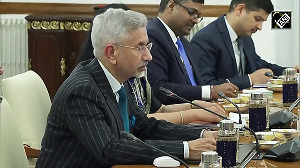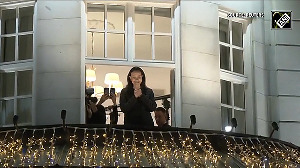It was a mammoth task, he remembers. In the winter of 1991 the Uttarkashi earthquake (in Uttarkhand) had killed thousands of people. Seeing 800 bodies in front of him made him go weak in the knees. As cold winter rain wreaked further havoc and the task grew bigger. These 800 bodies had to be cremated. Not buried.
But this gutsy 34-year-old, along with other volunteers and NGOs completed this colossal, emotion-wrenching assignement under difficult weather conditions.
It was this encounter that moved Chandrashekhar Hariharan take up the challenge of putting a human face to development and quality of life and he started Biodiversity Conservation [India] Limited, BCIL, in 1994. It is an alternate technology enterprise dedicated to creating 'green' solutions for urban living.
Earlier, after completing his CA in 1981 Chandrashekhar tried his hand as a financial journalist with The Indian Express, The Free Press Journal and later with The Times of India. He soon got bored with his job and with the Uttarkashi quake experience still haunting him he decided to set up BCIL in 1994.
Today, at 50, his company is worth Rs 80 crore (Rs 800 million) from a humble beginning in 1995 when his turnover was a mere Rs 2 crore (Rs 20 million). In the meantime, the number of eco-friendly houses that BCIL built has increased from 20 to over 150 in 2007 "all of them with no compromise on the green values."
Interestingly, Chandrashekhar achieved this feat against many odds.
To begin with, none of the people with whom he co-founded the company had the patience or the confidence that building eco-friendly homes as a career and business would blossom one day. He made it possible with his gumption and grit. He also showed that alternate careers are a viable and interesting way to achieving success.
In an e-mailed interview with rediff.com's Prasanna D Zore, Chandrashekhar shares his struggle, feats, disappointments and the vision that helped him succeed in an alternate career.
Tell us a little about your background.
I come from a modest middle class background with my early years spent in Bangalore foraging libraries for all that I could read on; anything that took my interest. I qualified as a Chartered Accountant in 1981 but moved away to become a financial journalist for the next two and a half years.
I was fortunate to secure a place for my Masters in econometrics and corporate communications from PennState, Harrisburg with a full fee waiver that helped fund my education. I then picked up a doctoral in econometrics with a thesis on the wave theory and the Indian economy.
I returned home to work on development economics and spent time with many voluntary organisations in Aurangabad (Maharashtra), Vishakhapatnam (AP), Jhansi (MP), Palamu (Bihar), Ganganagar (Rajasthan) and Dehradun (then in north east UP, now Uttarkhand). I worked on rehab plans after the Uttarkashi earthquake in the Garhwal region. Before moving on to work on water and watershed systems with devices that were mechanical energy oriented -- water-based flour mills, hydrams for lift irrigation, micromini hydel power units, and so on.
Give us a brief sketch of your career in various industries.
A brief five-month stint as a tax practitioner after qualifying as a CA, then as a financial journalist in the Financial Express, Free Press Journal and then in The Times of India, Bombay.
I was associated with The Action Research Unit, Delhi, in the late eighties before co-founding The Academy for Mountain Environics in 1991 at Dehradun. Four years later, I moved on from donor-funded models of the AME to create BCIL in 1995 as an enterprise that had sustainable development of water, energy and building practices as its central agenda.
When did you discover your sensitivity towards environment?
Having to deal with over 800 bodies after the Uttarkashi earthquake with the challenges of cremating them (not burying them) in the winter of 1991 with incessant rains that made the task harder created the (inspiration) in me to take on challenges that put a human face to development and quality of life.
The inequity of life where the poor pay more for essential things in life like water deepened my resolve to work towards technologies and solutions in urban and rural eco-systems that could reduce our eco-footprint while enhancing quality of life.
When did you decide to establish BCIL? What was the purpose/vision/mission?
BCIL was born in 1994 with the twin aims of a) water and energy technologies improving quality of life, while (b) such technologies had to be combined with an enterprise that could push conservation values without compromise on everyday living and lifestyles.
The purpose of BCIL is essentially to mainstream sustainability -- which means taking what are called 'alternate' technologies and establishing these into cutting-edge systems needed in the marketplace. Its vision is to make an impact with no impact at all, or to be able to tell people: We will care for the world so much that you don't have to. This means not judging urban lifestyles but complement it with softer eco-footprints.
Was it a struggle? What disappointments did you have to cope with?
It was not a struggle. It was a nightmare! Not one of the key resource persons who helped us start BCIL continue to be with us today. We spent nearly four years failing to deliver. We failed to understand simple needs of regulation and approvals. We failed to see the customer needs of timely and efficient delivery were consciously met. We didn't know how to build systems and processes. We worked like cornerstone entrepreneurs.
We lost five years in just building our first project. We had many unhappy customers who said, "They are a bunch of nice guys but don't know how to deliver."
Over the last seven years from 2000, we have learnt the hard way over five more projects that we have created. We lost a lot of money in the early years, but kept our clients. But we have now understood that sustainability is only another face of good, efficient management. Today, as an organisation, we are about 100 strong, growing to be 200 this year.
The disappointments are behind us now. The depth of management we have created has now ensured that we de-risk our processes. In all this, we have not lost sight of the need for pioneering and pro-typing. This is the soul of BCIL.
Can you tell me more about BCIL and what it does today?
We are today doing residential projects which offer affordable housing for the middle and upper middle class segments (from Rs 35 lakh to Rs 50 lakh a house with the best of luxuries) and social housing for industrial workers (from Rs 13 lakh to Rs 20 lakh a house).
We are creating destinations for responsible tourism -- at Goa and Coorg, which will be the first of a series of such destinations that celebrate biodiversity in India and elsewhere in the world.
We will be creating energy-efficient office spaces and shopping malls in Bangalore and elsewhere in India in years ahead that will help office blocks get air-conditioning and every other facility, but with a softer eco-footprint and at lower financial costs of maintenance. BCIL does not value judge urban lifestyles. We provide the same services that a regular building does but in a way that is sustainably developed.
How is BCIL different from the other players in the real estate industry?
How is BCIL different? As a house owner, you spend 40 per cent less on energy bills every month. In many of our campus creations, you don't need water supply, power supply and sewerage board from the outside. We achieve 100 per cent autonomy in these areas for the home owners. Our air conditioning is ozone-friendly -- no CFC or HCFC.
It is not 'air-conditioning' the way the world knows it; it is superior in that it keeps your room warm when cold outside, and vice versa. But we continue to call it air-conditioning since the marketplace understands this easily.
We use no bricks or clay tiles or clay blocks which need precious top soil for production. We use only 20 per cent concrete blocks. We are one of the largest makers of soil-stabilised blocks in India now; these are made out of the earth that we excavate for our buildings. We use energy-efficient pre-fabricated systems for walls and roofs. We don't use ceramic tiles.
We don't use anything but water conserving taps in our homes which save you up to 35,000 litres every year in every house! We use only non-toxic paints -- no chemical-based paints. All our waste water is treated fully and is used for our flush tanks and gardens. We don't use high energy incandescent bulbs and tube lights. We use only CFLs and LEDs in all homes and external spaces. We use only sustainably harvested wood for our houses -- either plantation or non-forest timber.
All our gardens are chemical-free with a combination of micro-irrigation systems, moisture retention plans that ensure reduced water use for soil beds; we are the first to introduce Zero Food Miles Programs which help you get greens, gourds, legumes, tubers and corn (we can't grow paddy and wheat in small patches of city lands!) that ensures that the vegetable you eat does not travel many miles to reach you.
All our homes are either carbon-neutral or carbon-positive and therefore gain 'carbon credits' -- this means a tangible, financial benefit for our home-owners on the annual carbon emission reduction.
Did you have a mentor, and if so, how did he/ she inspire you to steer your career in the right direction?
I had an opportunity to work with one mentor 26 years ago. God bless him. He is still around and writes a Sunday column for The Indian Express. His name is TJS George (the founding editor of Asiaweek).
I learnt from him that the best way to learn is to be just dumped into a task with no one to help you solve it -- and you will solve it. He said to me one day, "Your voice, however young you are, is as important as anyone else's." And I have always spoken my mind since then. I learnt that my opinion counts as much as that of any other person, young or old. I learnt that whatever one does, you have to learn to be the best in that area of work.
There are many others who inspired me with the sheer dedication that they brought to their work -- Aldo Leopold (Sand Almanac County), Rachel Carson (Silent Spring), David Thoreau and among those living legends of India, Anna Hazare, Dr Mishra who worked on the Chilka Lake in Orissa, and Sreedhar who champions many causes even today across India.
What tips do you have for today's architects / engineers who are looking at green architecture as a good career opportunity?
I have often told many engineers and architects that they should not just limit themselves to reading their own subject.
They must go beyond to understand how the world works, how nature works. To look at a building as an energy system; to understand what plugs in and plugs out of every building and how you can be responsible for all of it.
It is like your human body. It needs energy and water and puts out waste. All have to be handled effectively, efficiently. They should not look for a job. It won't help. They should be looking to see what they want to achieve in the long term for themselves. Like my mentor alwys told me: think how can you be the best at what you do, whatever that is.





